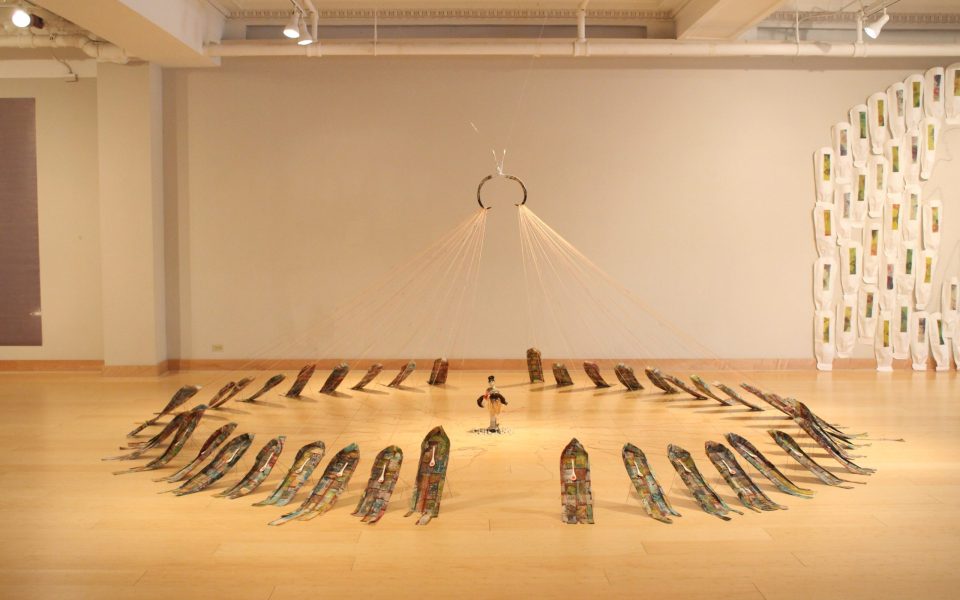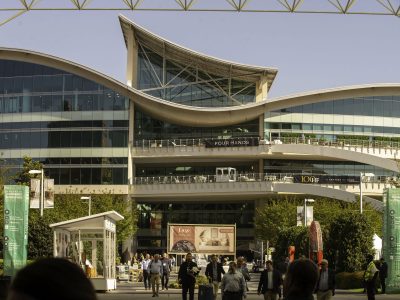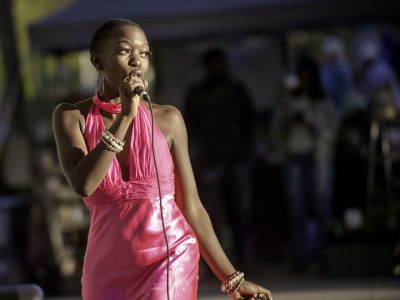Rather than awaiting use on a physician’s tray of disconcerting implements, crude obstetric forceps collect the ends of numerous strings at the peak of the conical, mixed-media installation. The strings hold up the tips of brightly printed bandage gauze, with layers of images from Jan-Ru Wan’s upbringing in Taiwan that she wove into the shape of houses, each holding a ceramic spoon in the center. The arrangement stops the beholder in their tracks, and that’s no mistake.
Slow Art is a new exhibit in the GreenHill gallery in the Greensboro Cultural Center on display through April 15. The collection highlights the work of four artists, each interested in enticing viewers into more contemplative states of being.
Wan’s elaborate fiber installations are the most visually striking upon entering the gallery, particularly “Hold Still; Still Holding.” A small, standing doll holds Wan’s quarter century-old braided hair in the center of the display. This organic feature symbolizes the inevitable passage of time and her identity as a woman, and rests beneath the cold forceps high above — a mechanical object capable of admitting babies into the world and their homes where culture is then learned. Throughout her work in the gallery, Wan juxtaposes the organic and inorganic, society and the individual and the cultures of the East and West.
In “Position to Write/ Position to Erase,” she suspends dozens of stiff, azure- and emerald-dyed fabric columns from a 10-feet-tall, 20-feet-wide suspended beam with tiny shirt collars at both ends, seemingly treated with too much starch. Wan implies control exerted over the masses but the varied printed images like dragonflies, a meditating man and anomalous splotches appear randomly throughout the set of shirts, indicating individual variations on universal experiences. She simultaneously alludes to the individual and the universal through the repetition of images and objects in her work. Short pencils (sans erasers) the vibrant colors of pink, orange and lime green highlighters dangle from the reddish beam above piglet-pink rubber cap erasers, toy soldiers and little mirrors, many of which lay on the ground where viewers might catch glimpses of themselves. Wan prods us to explore how we as individuals and as societies write and erase histories.[pullquote]Learn more about the exhibit at greenhillnc.org.[/pullquote]
Rather than present items for consideration, Leigh Ann Hallberg offers space for intention. “Portable Contemplation Cube” is a minimalist, eight-foot cubic structure that sometimes houses the artist’s drawings but is currently home to a nondescript stool positioned across from a potted plant, one of the only pieces explicitly encouraging observation of nature, though it’s worth noting this is domesticated in a highly curated, almost impossibly tidy space. The setup suggests the necessity of solitude and ritual for reflection. The light-colored wooden frame creates a matrix of 4-by-4 squares rendering smooth, semi-translucent inner walls of milky plastic paneling visible from the corner opening. The Wake Forest art professor offers a sanctuary within the formal gallery space where visitors can spend time in reflection. Is it foolhardy to think contemplative practices can be fully separate from everyday goings-on, or is Hallberg more so asserting that such spaces ought to be accessible to all?
Notably, the exhibit includes more than a dozen works by retired UNCG art professor Setsuya Kotani, who became the university’s first Japanese faculty member in 1974. Kotani deals in ceramics, but Slow Art features more than a dozen of his color field paintings, mostly featuring color shifts between pastels as subtle as a dreamy sunset during a windless dusk. If his acrylic paintings spoke from their cotton, linen, masonite or wooden bases, it’d be in a whisper. Most pieces soothe, however mysteriously, and a minority perturb, but all engender meditative stillness save a spare linear brush stroke at the edge of a painting or (mostly off-white) swirls that could be UFOs. Kotani’s work makes for a highly subjective viewing experience contingent on an individual’s memories, imaginative process and learned meanings of colors.
On the opposite wing, in the windowed space facing Davie Street, Jeannine Marchand’s smooth, monochromatic clay reliefs rest in dark steel frames. Most are rectangular; all contain folds that swell and retreat into unseen space, lending contrast and depth. The tightly-packed pleats in “Puerta,” meaning “door” in Spanish, epitomize the intense static energy that characterizes Marchand’s abstract series. More loosely contoured clay slabs bear likeness to a lover’s billowed bedsheets or eddied satin if its sheen were replaced with a matte finish and its density many times multiplied. But, really, they depict nothing, instead offering a metaphorical canvas poised to stir projections from the subconscious.
Slow Art proposes a heartening possibility: That it is within our reach to be reborn each hour of each day — not in the evangelist’s sense or with the assistance of Wan’s forceps, but a reawakening of our own volition, our own willingness to block out constant demands to produce and to be efficient, instead slowing down to engage ourselves and each other.
Join the First Amendment Society, a membership that goes directly to funding TCB‘s newsroom.
We believe that reporting can save the world.
The TCB First Amendment Society recognizes the vital role of a free, unfettered press with a bundling of local experiences designed to build community, and unique engagements with our newsroom that will help you understand, and shape, local journalism’s critical role in uplifting the people in our cities.
All revenue goes directly into the newsroom as reporters’ salaries and freelance commissions.





Leave a Reply